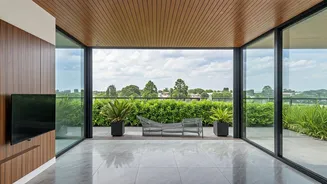Luxury Reimagined Today
The traditional definition of luxury, which focused on opulent interiors and lavish decorations, is being significantly reshaped. Experts in the field
are emphasizing a new perspective, where luxury is no longer simply about lavishness but a strategic incorporation of intelligent design, incorporating a fusion of structural efficiency, technological advancements, sustainability principles, and overall comfort. Contemporary homes should not only be visually pleasing, but they should also be designed to improve daily living experiences. This transformation is evident in the choices of materials and construction methods, with the focus shifting towards elements that support well-being and eco-friendliness. Leading consultants see the modern home as a thoughtful blend of form and function, designed to elevate living standards and reduce environmental impact.
Smart Design Principles
The evolution of luxury housing is being driven by the application of smart structural design principles. This approach integrates innovative technologies such as Building Information Modelling (BIM) and AI-enabled analysis into the construction process. BIM allows for real-time collaboration among architects, engineers, and fabricators through detailed 3D models. This ensures that every structural component is meticulously assessed for safety, regulatory compliance, and operational efficiency. AI tools further enhance this by identifying potential structural issues, optimizing material usage, and increasing building durability while carefully adjusting the design to suit various climatic conditions. Modern uPVC systems exemplify this innovative approach, combining durability, energy efficiency, and visual appeal, thereby redefining what comfort means in everyday living. They offer solutions such as sliding windows and doors, optimizing ventilation and usability, and blending classic charm with modern engineering.
Sustainable Building Materials
Beyond visual appeal, these modern structures make a tangible contribution to environmental sustainability. Materials like uPVC are crucial, due to their thermal insulation properties. This reduces energy consumption, which in turn, lowers the carbon footprint of the building. Their weather resistance and minimal maintenance requirements ensure longevity, reducing the need for frequent replacements and repairs. Moreover, they are often RoHS-certified, guaranteeing they are free from hazardous substances. This alignment of luxury with environmental responsibility is becoming a defining value of modern architecture. The emphasis on sustainable materials reflects a broader commitment to creating homes that are not only beautiful and comfortable but also contribute positively to the planet's health. This new generation of materials is reshaping the way homes are built and lived in, with a focus on long-term sustainability.
uPVC's Role in Luxury
uPVC doors and windows are at the forefront of this transformation, bridging aesthetics and intelligence. They have evolved from mere design choices into powerful statements of intent for homes. These materials combine the robustness and energy efficiency required for modern living with a sophisticated visual appeal. uPVC systems offer solutions like sliding windows and doors that achieve seamless indoor-outdoor transitions, as well as casement and tilt-and-turn designs to enhance ventilation and usability. These features contribute to enhancing the overall lifestyle experience, demonstrating that luxury is now about intelligent design that values both comfort and environmental responsibility. The focus on energy efficiency, security, and environmental sustainability of uPVC ensures that the homes are not only visually appealing but also contribute to a healthier and more sustainable living environment. In essence, uPVC exemplifies the evolution of luxury, reflecting a broader shift towards building practices that prioritize thoughtful design and eco-conscious choices.
The Modern Homeowner's Vision
Modern homeowners aspire to live in spaces that are technologically advanced, elegantly simple, and environmentally conscious. Experts believe that today's luxurious houses go beyond aesthetics, emphasizing the importance of functionality in design to raise living standards. Safety, sustainability, and resilience now form the foundations of modern luxury. Therefore, the new definition of luxury in India is about intelligent design sensitive to both comfort and environmental considerations. It's about creating homes that are not only beautiful and secure but also energy-efficient and kind to the planet. This paradigm shift reflects a move towards a more holistic approach to home design, one that considers the impact on both the residents and the environment. This transformation reflects a broader move towards building practices that emphasize thoughtful design and eco-friendly choices, driven by the desire for homes that are both luxurious and sustainable.



